Spray Painting Indoors
Indoor spray painting is a great way to easily and quickly finish furniture projects, but it requires proper preparation and safety measures. Yes, taking necessary precautions when spray painting indoors is important to avoid making a mess or risking harm from toxic fumes. We’ll discuss how to use a paint sprayer on furniture in an indoor space and the essential steps for preparing your workspace and yourself before spraying.
Spray painting can be a fun project, but it has risks, especially if you’re doing it indoors. Take steps to protect yourself and your workspace!
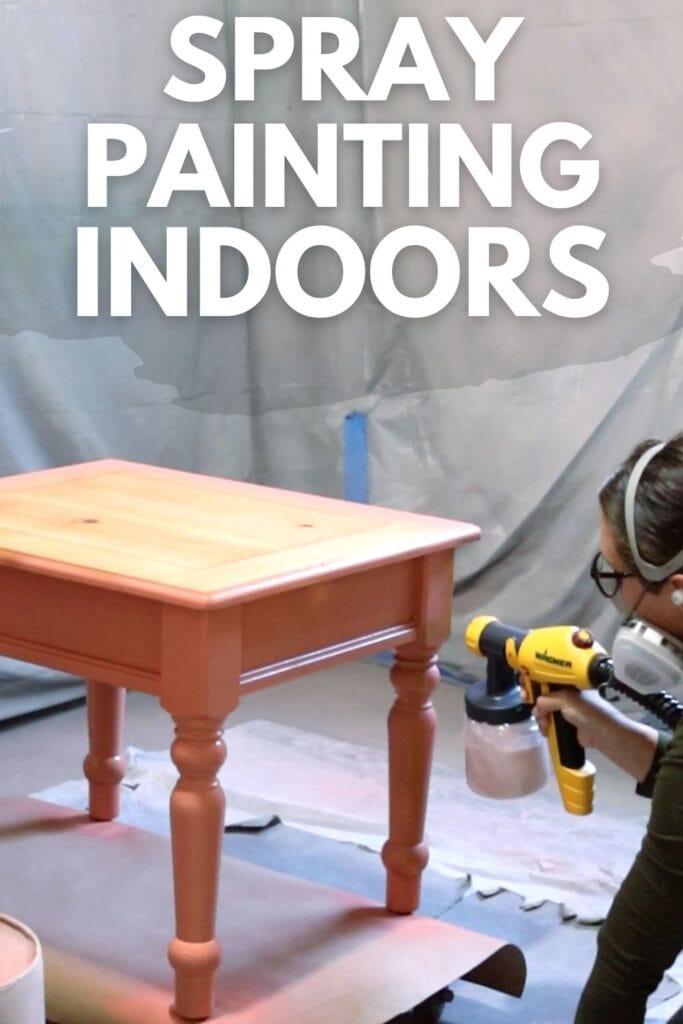
You should take certain steps to prevent overspray when painting furniture. You definitely don’t want paint getting all over surfaces or things it shouldn’t be on! I mean, who wants to deal with that mess, right?
Don’t forget about ventilation when spray painting indoors too! The right ventilation will help reduce the risk of inhaling paint fumes and keep your workspace from getting too stuffy. And remember to protect yourself! Wear a respirator suitable for paint and eye protection at all times.
We’ll share more tips below for setting up an indoor painting area, ventilation, and personal protection when spray painting.
As an Amazon Associate, I earn from qualifying purchases. I also may earn from other qualifying purchases with other companies or get free product to review and use. All opinions are my own.
Preparing Your Workspace
When it comes to spray painting furniture indoors, preparation is key!
Make sure you lay down some protection on the floor and around the room to keep the paint off stuff you don’t want it on. Here’s our blog post about how to prevent overspray when painting furniture to learn more about how to protect the surroundings when painting.
Plus, it’ll make cleanup a breeze later on. Here are some tips for protecting your workspace:
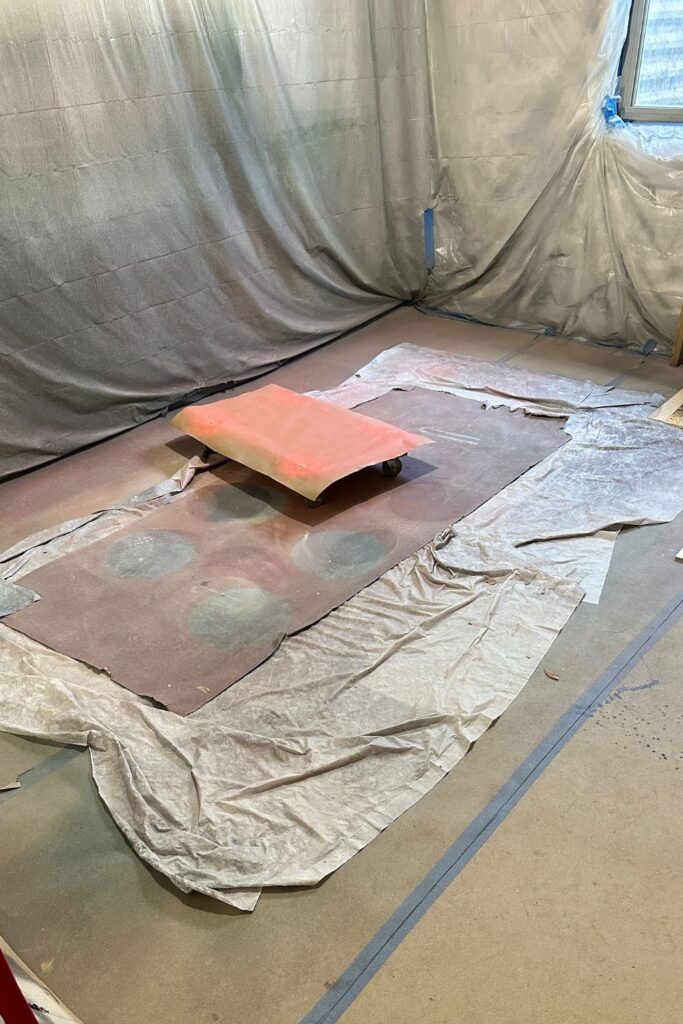
- Lay down plastic or cardboard on the floor and everything in the room. If you’re using water based paint, you don’t have to worry as much but if you are using oil based paint, it will be impossible to remove the paint from any surface it gets onto. It’s always better to cover more things than not enough.
- Use painters tape or masking tape to secure plastic and cardboard in place.
- For the best floor protection, use ram board which is a thick and durable cardboard type material. It’s reusable so you can use it over and over again for all your projects.
When getting your workspace ready for indoor spray painting, always consider the type of paint you’ll be using.
Water-based paints require less prep since they are easier to clean off surfaces and don’t have as strong odors as oil-based paints. However, if you decide to go with oil-based paint, you need to be extra cautious due to its high toxicity.
No matter what type of paint for furniture you use, the setup for your workstation is important. Taking the time to properly prepare your workspace is essential for a successful spray paint job.
If you want to use spray paint in the rattle cans on your project here is the best spray paint for wood furniture.
Ventilation for Spray Painting Indoors
Ventilation is an important safety measure to keep in mind when spray painting inside. Without proper ventilation, the fumes from the paint can accumulate and become overpowering as well as hazardous if there are heat sources in your work area… and obviously to your health.
Plus, if you don’t have enough fresh air circulating, your paint job might end up looking a bit rougher than you’d like.
The most effective way to ventilate an indoor space while spray painting is by opening windows. But, this isn’t enough in most cases and might be near impossible in other cases. So, the next best way to ventilate your area is with a fan and air filter box.
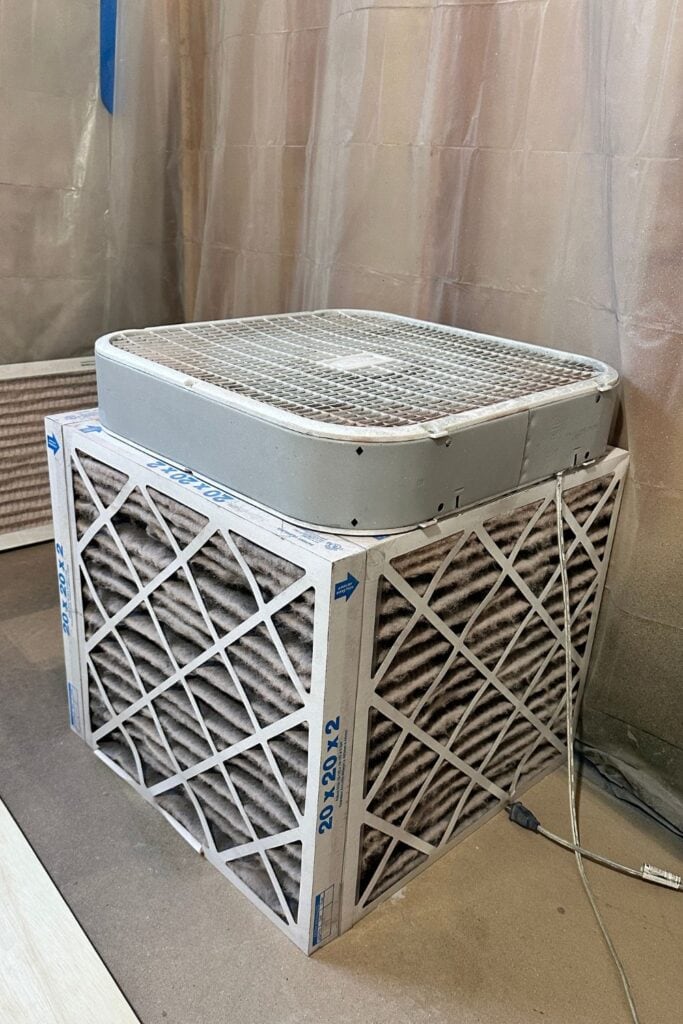
To create this setup, you need four 20″x20″x2″ air filters and a box fan. Tape the filters together to form a box with 4 walls, then place the fan on top of it with the fan blowing up towards the ceiling.
When you turn the fan on, it will pull air in and through the filters, which will catch the paint particles. Fresh air will be pulled up into the room as this is happening.
If you can, it’s also a good idea to open the windows for extra ventilation while you’re painting. This will help pull away fumes and keep your workspace from becoming stuffy or smelly during longer projects.
Personal Protection for Indoor Spray Painting
It’s extremely important to wear the right safety gear when spray painting indoors. Risks from paint fumes can be severe and even cause long-term health issues if you don’t take proper precautions.
The first line of defense is wearing a respirator that’s rated for paint. This will help prevent you from breathing in any harmful fumes or particles. Be sure to do your research and get the right type of respirator for your project.
In addition to a respirator, wear eye protection to shield your eyes from particles in the air and paint mist.
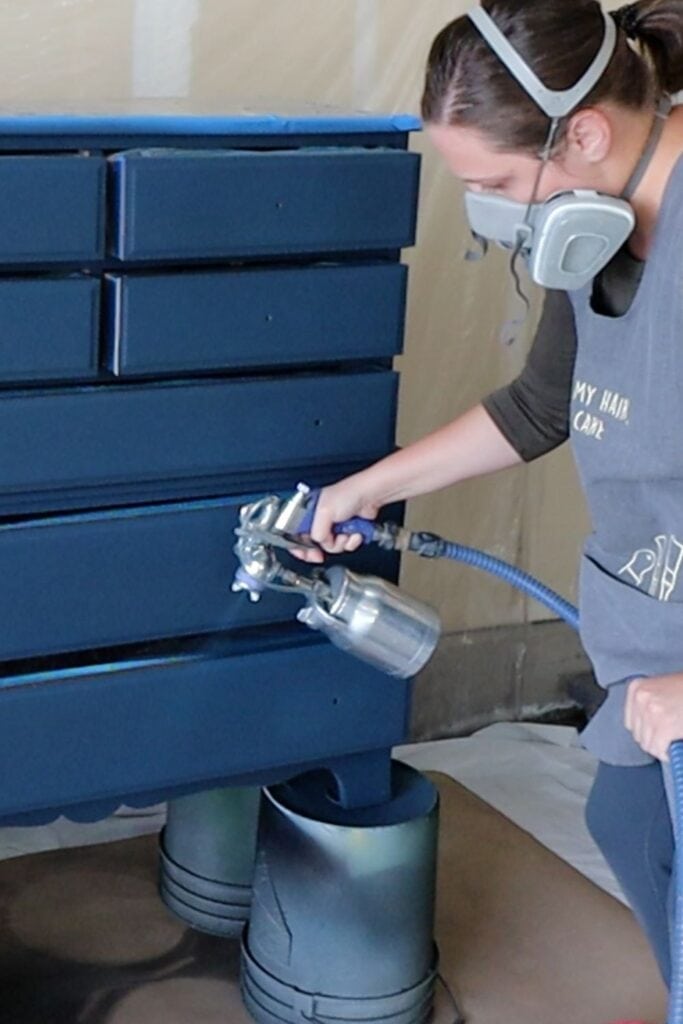
For oil based paints, it’s important to wear protective clothing such as a paint suit that even covers your head, since oil based paint is much harder to clean off than water based paint.
Safety gear might seem like an unnecessary step, but taking the time to protect yourself will pay off in the end. It’s important to take your safety seriously when spray painting especially indoors and always practice caution when working with potentially hazardous materials.
My Indoor Paint Booth Setup
When setting up an indoor paint booth, my top priority was to create a safe and efficient workspace for myself. In our unfinished basement, I use one bedroom area as my spray booth. I hung plastic from the walls and ceiling and placed ram board on the floor to keep it clean.
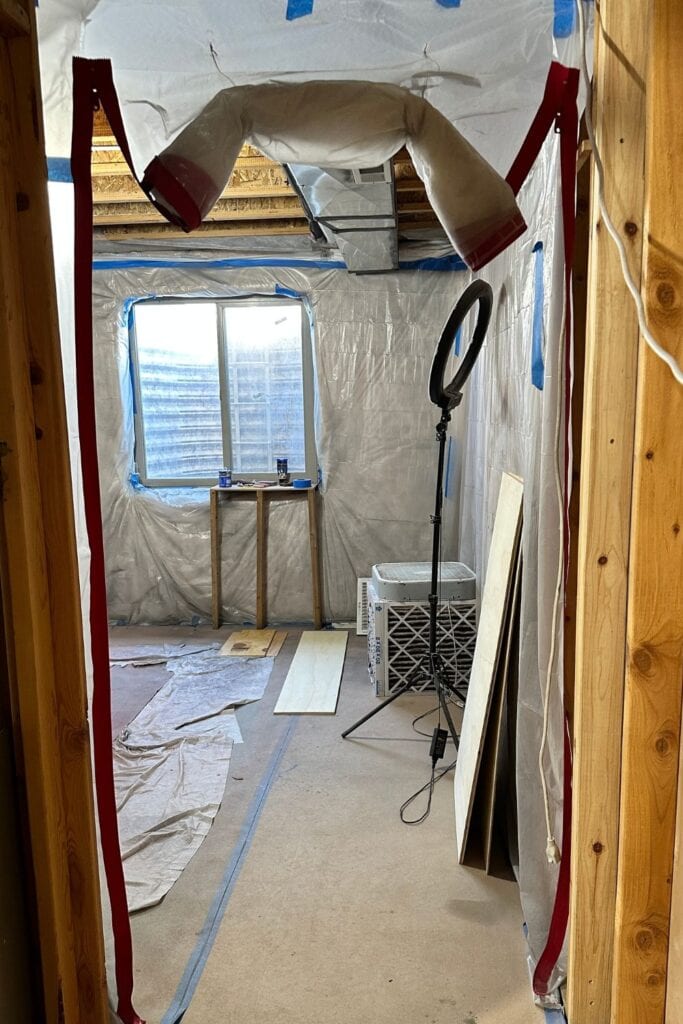
And to make sure there’s enough airflow, I set up a fan with an air filter box in the corner of the room. This helps get rid of fumes and paint particles while I’m working, which makes my projects turn out even better.
Something that you might not think of when setting up your spray booth is that ventilation also makes your paint look and feel much more professional. If you spray in a tight space, the overspray will get in the air, and then land on the top of your project, resulting in a rough finish.
Using the filters and the fan when spraying has almost completely eliminated the rough texture on our furniture tops! And it helps keep our workspace cleaner.
For my personal protection, I always wear my respirator to protect my health. When I first started, I skipped the respirator, but then I found myself getting sick easier and I would cough a lot more when I wasn’t sick. So I started putting my health first.
To be efficient, I always make sure I’ve got all the stuff I need before I kick off my project. This way, I save time and energy so I can focus on getting the job done smoothly.
Spray painting furniture indoors is a cool way to bring life to old pieces or give your home a touch of style. Making sure you’ve got a well-prepped workspace and good ventilation is key for a successful paint job and keeping yourself safe.
Taking personal protection seriously too is a must to protect your health. With the right prep, ventilation, and personal protection, you can enjoy spray painting indoors with confidence!
If you’re still undecided about which method to use for painting furniture, check out our guide to spray paint vs brush paint furniture.
More Spray Painting Tips
- Spray Paint Tools You Need When Painting Furniture
- Painting Furniture With A Sprayer
- Can You Spray Wood Stain With A Paint Sprayer
- Homeright Finish Max Paint Sprayer Review
- Best Paint Sprayer for Walls
Follow us on YouTube to get more tips for painting furniture.
Or share your project with us on our Facebook Group and be part of our community. See you there!

Thank you for all the info on spraying in doors. And the box fan with filters makes PERFECT sense!
I can now continue my projects WITHOUT waiting for the weather to warm up!
So glad it helps! Enjoy your projects!